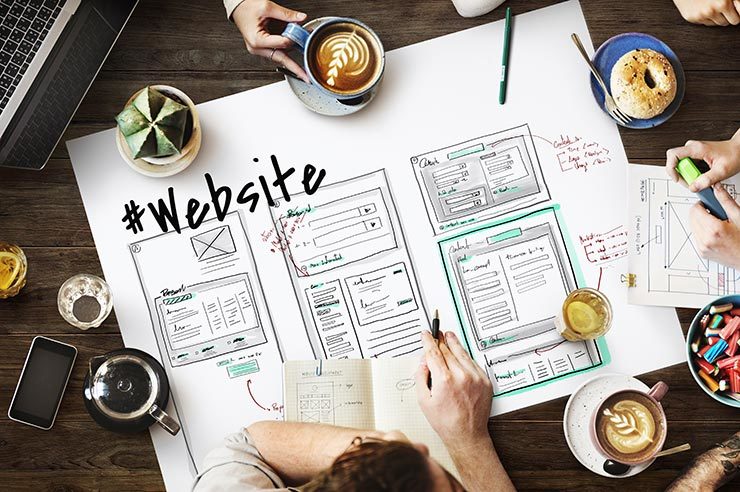As a professional marketer, I have seen firsthand how content and design are crucial in growing a new website. While it may seem like a debate between content vs. design, the reality is that both are equally important for the success of your website. In this blog post, I’ll explore the importance of content and design and how to find the right balance to grow your new website.
So let’s dive in and explore the world of content and design and how they work together to help you achieve your website’s goals.
Content: The Foundation of Your Website
When it comes to building a successful website, high-quality content is the foundation. It’s what drives traffic, engages visitors, and establishes your brand identity.
Why high-quality content is important
Your website’s content informs and engages your audience, establishes your brand identity, and ultimately drives traffic to your website. But what exactly makes content “high-quality,” and why is it so important?
First and foremost, high-quality content provides value to your audience. It should be informative, engaging, and tailored to meet the needs of your target audience. Creating content that resonates with your audience allows you to establish yourself as a thought leader in your industry and build trust with your visitors.
High-quality content is also critical for search engine optimization (SEO). Google’s algorithm favors websites that have valuable, well-written content. Regularly producing high-quality content can improve your website’s search engine rankings and drive more organic traffic.
Finally, high-quality content can help to increase conversions and drive revenue. Whether you’re selling products or services or simply looking to build your email list, well-written content that speaks to your audience’s pain points and needs can help to convert visitors into customers.
How to create valuable content for your website
Creating valuable content for your website can seem daunting, but it can be a straightforward process with the right strategy and approach. The key is understanding your target audience and their needs and creating content that speaks directly to them.
Steps you can take to create valuable content for your website:
Conduct audience research: Understanding your target audience is crucial for creating content that resonates with them. Conduct research to identify their pain points, needs, and interests. You can do this by analyzing your website’s analytics data, conducting surveys or polls, and monitoring social media activity.

Develop a content strategy: Once you understand your audience, develop a content strategy that aligns with your website’s goals and target audience. This should include the type of content you’ll produce, how often you’ll produce it, and how you’ll promote it.
Create well-written, engaging content: When creating content, focus on providing value to your audience. Make sure your content is well-written, engaging, and informative. Use storytelling techniques to capture your audience’s attention and keep them engaged.
Optimize your content for SEO: To improve your website’s search engine rankings, optimize your content for SEO. This includes using keywords strategically and providing value to readers with strategic linking.
Measure your results: Finally, measure the success of your content by analyzing your website’s analytics data. This will help you identify what’s working and not, so you can adjust your content strategy accordingly.
Examples of successful websites with great content
When creating valuable content for your website, it can be helpful to look at examples of successful websites that are doing it right. Here are some examples of websites with great content:
HubSpot: HubSpot is a marketing and sales platform that produces a wide variety of content, from blog posts and ebooks to webinars and podcasts. Their content is focused on helping businesses improve their marketing and sales strategies and is tailored to their target audience of marketers and sales professionals.
The New York Times: The New York Times is a well-known newspaper that produces high-quality journalism on various topics. Their content is informative and engaging and often goes in-depth on important issues to their readers.
Moz: Moz is a company that provides SEO tools and services. Their content is focused on helping businesses improve their search engine rankings and includes a wide range of resources such as blog posts, guides, and webinars.
Smashing Magazine: Smashing Magazine is a website that produces content for web designers and developers. Their content is focused on practical tips and advice for creating great websites and is often backed up by research and data.
The Spruce Eats: The Spruce Eats website provides recipes and cooking tips. Their content is focused on providing value to their readers by helping them improve their cooking skills and providing inspiration for new dishes.
All of these websites have one thing in common: they produce high-quality content that provides value to their audience. By tailoring their content to their target audience and focusing on providing value, these websites have established themselves as thought leaders in their respective industries and built a loyal following of readers.
Design: The First Impression
Design is the first impression your website makes on visitors. It captures their attention, creates a positive user experience, and sets your brand apart.
Why a good design is important
In addition to high-quality content, a good design is also crucial for the success of your website. Here are some reasons why:
First impressions matter: When visitors land on your website, they form an opinion about your brand within seconds. A well-designed website can create a positive first impression and establish your brand identity in the minds of your visitors.
User experience is key: A good design is essential for creating a positive user experience. A well-designed website should be easy to navigate, visually appealing, and optimized for mobile devices. Creating a user-friendly website can improve your visitors’ experience and keep them on your site longer.
Increased engagement: A good design can also help to increase engagement on your website. Using visual elements such as images and videos lets you capture your audience’s attention and keep them engaged with your content.
Improved credibility: A well-designed website can also improve your credibility with your audience. A professional-looking website can make your brand appear more trustworthy and established, leading to increased conversions and sales.
Better search engine rankings: Finally, a good design can improve your rankings. Google’s algorithm rewards websites with a good user experience, so a well-designed website can help improve your website’s SEO.
How to choose the right design for your website
Choosing the right design for your website can be a challenging process, but there are some key factors to consider that can help you make the right choice. Here are some tips for choosing the right design for your website:
Identify your website’s goals: Before you start designing your website, it’s important to identify your website’s goals. Are you looking to increase conversions, establish your brand, or provide information to your audience? Once you know your goals, you can choose a design that aligns with them.
Consider your target audience: Your website’s design should also be tailored to your target audience. Consider their needs, interests, and preferences, and choose a design that resonates with them.
Look for inspiration: There are many websites out there with great designs that can serve as inspiration for your website. Look for websites in a similar industry or with a similar target audience, and note what you like and don’t like about their designs.
Keep it simple: A simple, clean design is often the best website. Avoid cluttered designs with too many elements, as they can overwhelm your visitors.
Make it mobile-friendly: With more and more people using mobile devices to browse the internet, choosing a mobile-friendly design is important. Ensure your website is optimized for different screen sizes and easy to navigate on mobile devices.
Consider your brand identity: Your website’s design should also be consistent with your brand identity. Choose colors, typography, and other design elements that align with your brand and create a cohesive look and feel.
Examples of successful websites with great design
When choosing the right design for your website, it can be helpful to look at examples of successful websites that have done it well. Here are some examples of websites with great design:
Apple: Apple is well-known for its sleek and minimalist design aesthetic. Its website is clean, easy to navigate, and showcases its products in a visually appealing way.
Dropbox: Dropbox’s website features bold colors and engaging animations that draw visitors in and keep them engaged. The website is also easy to use and highlights the service’s benefits.
Nike: Nike’s website features a high-contrast black-and-white design that is visually striking and easy to navigate. The website also features engaging product images and videos that showcase its products in action.
Squarespace: Squarespace’s website is well-designed and easy to use, showcasing the company’s design capabilities. The website also features a range of examples of websites built on the Squarespace platform.
Hims: Hims is a men’s health and wellness company with a website with a clean and modern design. The website is easy to navigate and features engaging product images and descriptions.
These websites have one thing in common: well-designed layouts, clean designs, and engaging visuals that draw visitors in and keep them engaged. By focusing on user experience, these websites have established themselves as thought leaders in their respective industries and built a loyal following of users.
Content vs. Design: Finding the Right Balance
Finding the right balance between content and design is crucial for creating a successful website.
Why you need both content and design for a successful site
While high-quality content and a good design are important components of a successful website, they are not mutually exclusive. The best websites combine both content and design to create a seamless user experience that engages visitors and achieves the website’s goals. Here are some reasons why you need both content and design for a successful website:
Content and design work together: A well-designed website can make your content more visually appealing and engaging. High-quality content can provide value to your visitors and keep them on your website longer. Together, they create a cohesive user experience that helps to achieve your website’s goals.
Differentiate your website from competitors: In today’s digital world, it’s important to differentiate your website. Investing in content and design can create a unique and memorable website that stands out from the competition.

Meet user expectations: Users expect high-quality content and a good design from websites. By providing both, you can meet their expectations and provide a positive user experience that keeps them returning to your website.
Improve search engine rankings: A well-designed website with high-quality content can improve your rankings and drive more organic traffic to your site. Google’s algorithm favors websites with both, so investing in both can help boost your website’s SEO.
Build brand identity: Content and design are essential for building a strong brand identity. By creating high-quality content that aligns with your brand’s messaging and using a design that reflects your brand’s values and aesthetic, you can establish your brand identity and build a loyal following of visitors.
How to balance content and design effectively
Balancing content and design can be tricky, but it’s essential for creating a successful website. Here are some tips for balancing content and design effectively:
Identify your website’s priorities: Before designing or creating content, identify your website’s priorities. This could be increasing conversions, building brand awareness, or providing information to your audience. Once you know your priorities, you can create a content and design strategy that aligns with them.
Tailor your content to your design: Your content and design should work together to create a cohesive user experience. Consider how your content can be tailored to your design and vice versa. For example, you could use design elements such as images and videos to showcase your content or typography and color to highlight key messages.
Use white space effectively: White space, or negative space, is an important design element that can help to balance your content and design. Use white space to create a clean, organized design that doesn’t overwhelm visitors with too much content.
Test and iterate: Finally, don’t be afraid to test and iterate your content and design strategy over time. Analyze your website’s analytics data to see what’s working and what’s not, and adjust accordingly.
Examples of successful websites with the right balance
Finding the right balance between content and design is crucial for creating a successful website. Here are some examples of websites that have found the right balance:
Airbnb: Airbnb’s website features a clean and simple design that highlights its listings and makes it easy for users to find what they want. The website also features engaging visuals that showcase its properties and make the website feel more welcoming.
Buzzfeed: Buzzfeed’s website features a bold and colorful design that reflects its brand identity. The website is also filled with engaging content tailored to its target audience and keeps visitors returning for more.
Patagonia: Patagonia’s website features a minimalist design that highlights its products and aligns with its brand identity. The website also features high-quality content that reflects its commitment to sustainability and outdoor recreation.
Dropbox Business: Dropbox Business’s website features a clean and modern design that highlights its features and benefits. The website also features engaging visuals and high-quality content that resonates with its target audience of business professionals.
The North Face: The North Face’s website features a visually appealing design and easy to navigate. The website also features high-quality content that showcases its products and aligns with its brand identity.
How to Grow a New Website
Growing a new website requires a combination of high-quality content, a good design, and effective marketing strategies.
The role of content and design in growing a new website
Content and design play crucial roles in growing a new website. Here are some ways that content and design can contribute to the growth of a new website:
Establishing a strong brand identity: A well-designed website with high-quality content can help to establish a strong brand identity, which is essential for growing a new website. By creating a website that reflects your brand’s values and aesthetic, you can attract and retain a loyal following of visitors.
Driving traffic: High-quality content and a good design can also help to drive traffic to your website. By creating optimized content for search engines and using design elements that make your website easy to navigate, you can improve your website’s visibility and attract more visitors.
Converting visitors into customers: Finally, a good design and high-quality content can also help to convert visitors into customers. By providing value through your content and making it easy for visitors to take action through design, you can improve your website’s conversion rates and grow your business.
Strategies for growing a new website
Here are some strategies for growing a new website with great content and design:
Develop a content strategy: Start by developing a content strategy that aligns with your website’s goals and target audience. Identify the types of content you want to create, such as blog posts, videos, or infographics, and create a schedule for publishing them. Ensure your content is high-quality, valuable, and optimized for search engines.
Invest in a good design: Invest in a good design that reflects your brand identity and creates a positive user experience. Consider hiring a professional designer or using a website builder that offers high-quality templates. Make sure your design is responsive and optimized for mobile devices.
Use social media: Use social media to promote your content and drive traffic to your website. Share your content on platforms like Facebook, Twitter, and Instagram, and engage with your followers to build a loyal following.
Focus on SEO: Focus on SEO to elevate your website in search results and drive organic traffic. Use keywords in your content and meta descriptions, optimize your website’s structure and navigation, and build high-quality backlinks to your website.
Analyze and optimize: Finally, analyze your website’s analytics data to see what’s working and what’s not and make adjustments accordingly. Use tools such as Google Analytics to track your website’s traffic, engagement, and conversion rates and optimize your content and design based on the insights you gain.
Contact Oyova For Content or Design Services
Content and design are critical to growing a new website. While high-quality content is essential for providing value to your visitors and improving your search engine rankings, a good design is necessary to create a positive user experience and establish a strong brand identity. Finding the right balance between content and design allows you to create a website that engages visitors, achieves your goals, and reflects your brand identity.
To grow a new website with great content and design, develop a content strategy that aligns with your website’s goals and target audience. Invest in a good design that reflects your brand identity and creates a positive user experience. Use social media, SEO, and analytics to promote your content, improve your website’s visibility, and optimize your content and design over time.
Ready to take your website to the next level with great content and design? Contact Oyova today to learn more about our web design and content marketing services.
